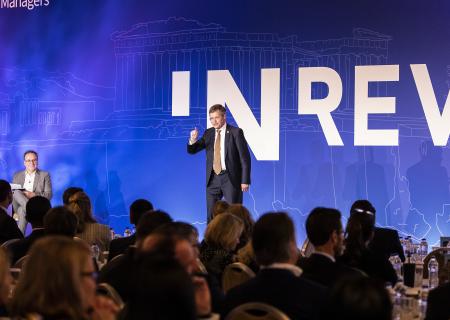Inclusion is also a choice
A major topic for the 2022 Young Professionals Conference
At this year's Young Professionals Conference we will be touching on the very important topic of inclusion with Ernst Dekker, Dekker & Van Velzen. Ernst shares some of his thoughts with IQ before he takes to the stage.
Both in conversations with my clients as in most (academic) research, the theme of inclusion is mainly discussed from the context of the (work) environment. The DEI (diversity, equity and inclusion) policy of many organisations focuses on the context of the organisation as a whole. The question is often: what can 'the organisation' do to make colleagues feel more inclusive? What does this mean for the strategy and what are the implications in terms of leadership, attitude and behaviour?
I am convinced that this is only half the story. What makes it natural for some to take their own place and for others in the same environment to be careful or even anxious because of the fear of exclusion? And what does that mean for the employee's experience of inclusion?
Many people believe that more diversity 'automatically' leads to more inclusion. However, we often see the opposite: increased diversity in a team or department can initially lead to a decrease in inclusion. The psychological safety in the group decreases because there are different subgroups with mutually differentiating characteristics that are homogeneous within their own subgroup (for example, gender, sexual orientation, different cultural backgrounds, etc.). In the subgroup people feel safe because there are 'like-minded people' in it, but between the subgroups, the safety and with it the inclusion decreases.
Many people believe that more diversity 'automatically' leads to more inclusion. However, we often see the opposite: increased diversity in a team or department can initially lead to a decrease in inclusion
You can say that on an individual level, the degree of inclusion is determined by the fulfilment of two basic needs: on the one hand the need for authenticity and on the other hand the need for belonging. If both needs are met at the level you desire, you will experience inclusion. After all, you can be who you are and at the same time be part of the groups you want to belong to.
For some people, the desire to (continue to) belong to a group is so intense that they are willing to compromise on authenticity. Out of fear of being excluded from the group, they adapt to the group norm (assimilation). Other people may do the opposite; because of the pride in their own personality, they are not prepared to adapt to a group norm (differentiation). What connects the two groups is the lack of a sense of complete inclusion.
the degree of inclusion is determined by the fulfilment of two basic needs: on the one hand the need for authenticity and on the other hand the need for belonging. If both needs are met at the level you desire, you will experience inclusion
Inclusion is also about connecting with yourself. Contact with your own pride or shame on some aspects of who you are. It is usually not that difficult to connect with pride; connecting with shame is another story.
This shame often stems from a certain degree of stigmatisation. Stigmatisation is the process by which certain characteristics are assigned to a certain person or group. Stigmatisation occurs both externally and internally.
Inclusion is also about connecting with yourself.
External stigma consists of two components: Cultural/social stigma describes how certain assumptions are deeply and often unconsciously embedded in social institutions (eg within legislation or religion). Organisational stigma perpetuates and confirms these assumptions within the organisation. These assumptions concern, for example, the difference in suitability between men and women for certain (senior) positions, the linking of service and customer orientation to sexual preference, the degree of tolerance towards people who think differently in relation to a religious conviction, etc. These assumptions lead to conscious and unconscious prejudices about certain groups of employees. We call this the 'unconscious bias'.
The internal or individual stigma stems from individual behaviour that promotes stigma and ranges from exclusion to violence. If you've been bullied, if you've been verbally abused in your workplace, or if you've been joked about once, next time you'll be wary and less candid about yourself. This is about experiences and actions that actually took place.
The individual may be aware of a particular stigma and its consequences, whether or not they are directly affected by that stigma. This can lead to 'minority stress', which manifests itself in constant fear and the use of preventive coping strategies (including identity concealment) based on the perceived stigma. This concerns the fear of a possible reaction, regardless of whether it actually takes place.
People with an individual stigma conceal a part of themselves. There is shame for certain aspects of one's own personality and/or associated lifestyle. The employee feels that he or she cannot be completely who he or she is, and therefore adjusts the behaviour and/or appearance to avoid exclusion. The need for belonging is so strong that people are willing to make concessions on the need for authenticity.
As mentioned, stigma – and its impact on authenticity and belonging – is related to the perceived degree of inclusion. The individual stigma is continuously fed by experiences from revealing versus concealing (authenticity) and by experiences from connecting versus excluding (belonging).
Inclusive leadership is working on an inclusive culture in which there is room for diversity. I call this DEI from an organisational perspective: what does 'the organisation' do to make the employee feel more inclusive and what does this mean for leadership and leadership development?
Inclusive leadership is working on an inclusive culture in which there is room for diversity.
I believe we can do even more. When the organisation also pays attention to recognition and acknowledgment of internal stigmatisation, there is more room for the employee to work on his or her own inclusion. This is about personal leadership development where the individual is supported to feel safe and is challenged to take his or her place in the team without compromising on authenticity.
Ernst Dekker is co-founder of Dekker & Van Velzen. They facilitate organisations, teams and individuals in the field of leadership development and executive (team) coaching. Before that, Ernst held international senior leadership roles at larger corporates.









